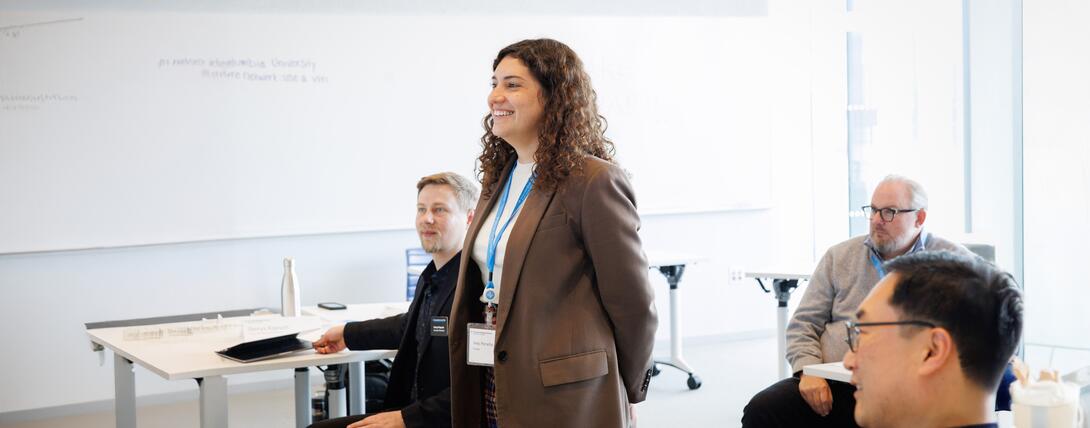
Unlocking Behavioral Drivers in Digital Sales with Inés Peralta Agüero
- Can you tell us a bit about your role at Google?
- What behavioral dynamics were you hoping to better understand?
- What key insight from the program impacted how you lead your team or engage clients?
- How did the program content resonate with your environment?
- Have you experimented with behavioral nudges in your sales strategy?
- How did the program help elevate your team culture or coaching approach?
- What advice would you give to other high-growth sales leaders?
Q&A with Inés Peralta Agüero
As a sales manager at Google based in Dublin, Inés Peralta Agüero leads a high-performing team within the Google Customer Solutions (GCS) division, focused on helping businesses across Spain and Portugal achieve their digital marketing goals. In this role, she’s responsible for business growth, strategic stakeholder engagement, and building a culture of coaching and development across her team.
Looking to deepen her understanding of human behavior and motivation in high-growth environments, Inés joined the Behavioral Science in Business program at Columbia Business School Executive Education. She brought a keen interest in how behavioral dynamics shape leadership and sales—especially when it comes to building influence and sustaining motivation in fast-paced, high-stakes environments.
We asked Inés to share how the program helped her reframe team culture, navigate complex decisions, and apply behavioral insights to real-world sales challenges.

Can you tell us a bit about your role at Google?
As a sales manager at Google, I lead an 11-person team, primarily focused on driving business growth for Google Ads solutions across the Spain and Portugal markets. I'm focused on building a high-performance culture, helping my team members unlock their full potential to consistently achieve their business and personal objectives. Beyond that, a big part of my role involves connecting with and influencing key internal and external stakeholders, whether by supporting sales proposals or leading strategic internal initiatives to hit our goals.
What behavioral dynamics were you hoping to better understand?
Before the program, I was focused on getting a better understanding of human behavioral dynamics in both sales and leadership. I wanted to understand why people act (or don't act) the way they do, especially in these professional settings. This was particularly relevant for me because one of the ongoing challenges in my role is finding effective ways to re-energize and motivate my team members during tough times. I was interested in learning how I could help my team adopt behaviors that would lead them to more positive results.
Beyond that, I was curious about the main factors influencing decision-making processes, both at business negotiations and personal conflicts, as this is a big part of what I do every day as a Manager. Ultimately, my goal was to really dive into human behaviors and motivations so I could apply those insights more effectively in my role.
What key insight from the program impacted how you lead your team or engage clients?
One of the most significant insights I gained was the profound importance of context, motivation, and implementation ability when driving any change. It really highlighted that humans inherently seek a sense of purpose, autonomy, competence, and connection. This understanding fundamentally shifted how I approach both team leadership and client engagement.
It was particularly eye-opening to realize that in business negotiations, while we often assume monetary incentives are the decisive factor, social and environmental considerations can actually carry equal or even greater weight in decision-making. This broadened my perspective immensely. I now pay much closer attention to the unintended signals our incentives might create, recognizing that every individual is different, and their motivations to embrace (or resist) change can vary significantly.
As the saying goes, "Leadership is to see what everybody else has seen, and to think what nobody else has thought." This program truly equipped me to look beyond the obvious and consider the deeper behavioral drivers at play, allowing me to approach challenges and opportunities with a much more nuanced and effective strategy.
How did the program content resonate with your environment?
In fast-paced environments like the tech industry, it’s easy to make the mistake of rushing into problem solving mode in order to “save” time. One key takeaway of this course was the importance of beginning any analysis with a clear, tangible end in mind – it helps to define what success looks like from the start.
Something I'm keen to implement in my day-to-day is taking the time to identify our "I Wish I Knew" (IWIKs), since this can help us pinpoint data gaps and clarify exactly what information we need to seek, maintain, ignore, or even stop collecting.
The program also provided a valuable mindset shift: to stop treating all decisions as if they were life-or-death to really drive more agility and experimentation. The LIMES methodology also resonated strongly with me as a helpful framework for evaluating viable ideas, allowing us to prioritize those that are most likely to influence behavior positively and are also easier to implement and measure.
Have you experimented with behavioral nudges in your sales strategy?
One significant challenge our sales teams often face is generating a stronger sense of urgency and commitment from clients, especially since their internal marketing teams are frequently stretched thin with competing priorities. We often see a delay in moving forward with the implementation of strategies we've agreed upon.
After the program, I've become much more intentional about implementing specific sales 'nudges' to influence these behaviors. For example, I've been actively using Loss Aversion by clearly highlighting what a client stands to miss out on by not adopting our proposed solutions. We've also focused on simplifying choices, reducing the number of options presented to make decision-making easier for them. And finally, we're leveraging the power of getting a small initial commitment from clients, as a way to increase the likelihood of them moving forward with larger, more impactful engagements down the line. These approaches have been really helpful in addressing that key challenge.
How did the program help elevate your team culture or coaching approach?
The program significantly helped me refine my coaching approach. A major takeaway was the importance of truly understanding the objective I want to achieve before jumping straight into ideation or problem-solving. This disciplined approach ensures we're solving the right problem.
A really impactful concept was what we called "videotalk" – essentially asking: "If we could capture that desired behavior on camera, what exactly would it look like?" This method has been incredibly useful for articulating clear, observable behaviors, which makes coaching much more concrete and actionable.
Beyond that, the program reinforced the absolute importance of communication alignment. Ensuring everyone is on the same page, not just about the what, but also the how and why, has been key to fostering a more cohesive and high-performing team culture.
What advice would you give to other high-growth sales leaders?
When leading a team, especially in fast-paced companies with high stakes and ambitious goals, we often pour most of our attention into our team members' ability to complete their tasks. We dedicate significant effort and resources to upskilling them, which is absolutely crucial.
However, we frequently neglect to consider what might be impacting their intention and, critically, their motivation. It's truly worth taking the time to dive deeper into understanding what drives the people around us to feel more or less motivated to act in certain ways.
We should never underestimate the profound impact of social and environmental triggers. In a business context, we're always dealing with people, and they are impacted very differently by the economic, social, and environmental factors surrounding them. Most leaders genuinely want to keep their teams motivated, but we sometimes fail to intentionally use the right levers to consistently create and maintain that high level of motivation. This program really helped me identify and apply those levers more effectively.
Sign Up for Email Alerts
Sign up for program updates and content relevant to today's business leaders from Columbia Business School Executive Education.
